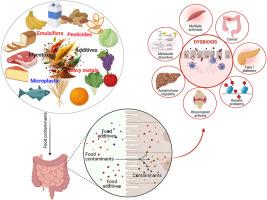The potential influence of food additives and contaminants on the gut microbiota: A comprehensive review
IF 3.5
3区 医学
Q2 FOOD SCIENCE & TECHNOLOGY
引用次数: 0
Abstract
Gut microbiota (GM) is a complex consortium of diverse microbes in the gastrointestinal tract, which collectively sustains host health through various physiological processes. GM's health benefits include regulation of host immunity, neurotransmitters, intestinal epithelium, energy absorption, and short-chain fatty acids (SCFAs) production. The extensive utilization of additives and the presence of contaminants in food has raised concerns regarding the GM. Chemical compounds such as pesticides, potentially toxic elements, microplastics, antibiotics, and certain food additives (e.g., emulsifiers, sweeteners, preservatives) have been shown to disrupt the GM's composition, leading to gut dysbiosis with subsequent adverse health effects. The complex mechanisms through which these substances affect microbiota lack a thorough understanding, although animal studies have provided new insights into the dysbiosis caused by these substances in the GM. This review aims to comprehensively explore the interaction of food additives and contaminants with the equilibrium of GM, with strong emphasis on their influence on gut health. We outline these substances as causing inflammation, gastrointestinal injury, altered short-chain fatty acids and polyamines' synthesis, higher expression of pro-inflammatory cytokines, and hepatic lipid metabolic disorders. Further studies are needed to understand the mechanisms and impact of such negative effects of food additives and contaminants on GM's integrity.

食品添加剂和污染物对肠道菌群的潜在影响:综述。
肠道微生物群(GM)是胃肠道中多种微生物的复杂联合体,它们通过各种生理过程共同维持宿主的健康。转基因的健康益处包括调节宿主免疫、神经递质、肠上皮、能量吸收和短链脂肪酸(SCFAs)的产生。添加剂的广泛使用和食品中污染物的存在引起了人们对转基因食品的关注。化学化合物,如杀虫剂、潜在有毒元素、微塑料、抗生素和某些食品添加剂(如乳化剂、甜味剂、防腐剂)已被证明会破坏转基因食品的成分,导致肠道生态失调,随后对健康产生不利影响。这些物质影响微生物群的复杂机制缺乏透彻的了解,尽管动物研究为转基因中这些物质引起的生态失调提供了新的见解。本文旨在全面探讨食品添加剂和污染物与转基因平衡的相互作用,重点关注它们对肠道健康的影响。我们概述了这些物质引起炎症,胃肠道损伤,改变短链脂肪酸和多胺的合成,促炎细胞因子的高表达和肝脏脂质代谢紊乱。需要进一步的研究来了解食品添加剂和污染物对转基因完整性的负面影响的机制和影响。
本文章由计算机程序翻译,如有差异,请以英文原文为准。
求助全文
约1分钟内获得全文
求助全文
来源期刊

Food and Chemical Toxicology
工程技术-毒理学
CiteScore
10.90
自引率
4.70%
发文量
651
审稿时长
31 days
期刊介绍:
Food and Chemical Toxicology (FCT), an internationally renowned journal, that publishes original research articles and reviews on toxic effects, in animals and humans, of natural or synthetic chemicals occurring in the human environment with particular emphasis on food, drugs, and chemicals, including agricultural and industrial safety, and consumer product safety. Areas such as safety evaluation of novel foods and ingredients, biotechnologically-derived products, and nanomaterials are included in the scope of the journal. FCT also encourages submission of papers on inter-relationships between nutrition and toxicology and on in vitro techniques, particularly those fostering the 3 Rs.
The principal aim of the journal is to publish high impact, scholarly work and to serve as a multidisciplinary forum for research in toxicology. Papers submitted will be judged on the basis of scientific originality and contribution to the field, quality and subject matter. Studies should address at least one of the following:
-Adverse physiological/biochemical, or pathological changes induced by specific defined substances
-New techniques for assessing potential toxicity, including molecular biology
-Mechanisms underlying toxic phenomena
-Toxicological examinations of specific chemicals or consumer products, both those showing adverse effects and those demonstrating safety, that meet current standards of scientific acceptability.
Authors must clearly and briefly identify what novel toxic effect (s) or toxic mechanism (s) of the chemical are being reported and what their significance is in the abstract. Furthermore, sufficient doses should be included in order to provide information on NOAEL/LOAEL values.
 求助内容:
求助内容: 应助结果提醒方式:
应助结果提醒方式:


